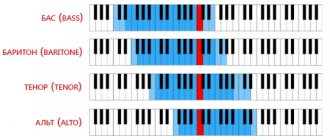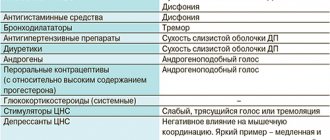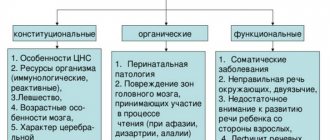All professional singing voices have a broad classification, while earlier, during the formation and development of a vocalist’s skill, it was quite simple, and was divided into only four types of voices - contralto and soprano for women, and bass and tenor for men. By and large, the same division system is still used today, but the range of voices has expanded significantly, and intermediate voices have emerged.
Range is how many notes you can hit, from low to high, without falling into falsetto or going out of tune by trying to lower your voice further than you can handle. Knowing your range, you can choose a successful repertoire that will favorably emphasize the beauty of your timbre.
Types of female singing voices
Female voices are divided into two groups - soprano and contralto. High voices (soprano) are divided into:
- Coloratura, or lyric-coloratura , is the highest of female singing voices;
- Lyric - a voice of a soft, gentle timbre, a common type, some call it the “basic” for a soprano group;
- Lyric-dramatic - a voice that has great mobility and variability in performance, the owners of which can “pull out” both the parts of lyric and dramatic soprano;
- Dramatic - a rare voice that has a range from mezzo-soprano to coloratura;
- Mezzo-soprano - characterized by a rich, deep sound, it is sometimes confused with a dramatic soprano, a type of voice that has absorbed the characteristic features of both contralto and soprano.
Examples of soprano sound
- Opera
- Variety
- Mezzo-soprano
- Contralto is the lowest of female singing voices, rich in deep sound throughout the entire range.
Voice classification
Types of singing voices can be classified according to different parameters. The first attempts to implement this were made in the 12th-13th centuries. The currently accepted characteristics of singing voices took shape in the 14th century. with the development of polyphonic choral singing. That's when they were divided by performer's gender and range. At first there were 4 main voices accompanying the music - two male and two female (bass and tenor, soprano and alto).
The increasing complexity of the repertoire led to a more detailed differentiation of voices, which first appeared in the Italian opera school. The characteristics took into account tonality, timbre, working range, tessitura (comfortable singing zone).
Types of male singing voices
Among men, these are tenor, baritone and bass groups. Among the tenors (high voices) we can distinguish:
- The countertenor is a rare, very high voice, it is quite easy to confuse it with a female soprano without seeing the performer;
- Tenor altino is the highest (with the exception of countertenor) of male singing voices;
- Lyric – analogous to the lyric soprano, has the same soft timbre and sound; Characteristic - a unique voice, used, as a rule, in operas and productions, having many characteristic touches that create an idea of the personality of the character being represented;
- Lyric-dramatic - can perform the roles of both lyric and dramatic tenor with equal ease;
- Dramatic - a voice that has greater strength and dramatic coloring than a lyric-dramatic tenor.
Tenor sound example
Baritones (considered an intermediate voice between bass and tenor) are divided into:
- Lyric - close in sound to tenors, but still having a baritone coloring, voice;
- Lyric-dramatic - the brightest voice in color and sound among baritones, whose owners can perform parts of both a lyrical and dramatic nature;
Dramatic - the strongest, deepest of this type of voices, having a gloomy coloring.
Examples of baritone sounds:
- Opera baritone
- Variety baritone
Bass (low voices) are divided into:
- High bass, or cantante (also called “singing”) - has a light sound, easily confused with a baritone;
- Central - deep voice, pronounced bass character with great possibilities, may be somewhat dull in the upper register;
- Low (profundo), or “bass-octavist” - a rare, very low, chesty, deep voice.
The lowest bass in history made it into the Guinness Book of World Records by producing a note that sounded eight octaves lower than the lowest note on a piano! This sound can only be heard by large animals or humans, provided that special equipment is used.
What is range
Range is the volume of sound. These are the singer’s potential abilities to hit certain notes. We all have a certain range from birth. It can be developed by several tones if necessary. It is obvious that the frequency range of men's and women's voices is different. This is noticeable even in normal conversation. Men have a rougher voice. This is due to the thicker vocal folds they are given at birth.
Register – a certain area of sound volume. It can be top, middle or bottom. Used as a separate voice data measurement capability.
Women's and men's singing abilities are divided into several types.
The strong half of humanity is characterized by bass, baritone and tenor. Accordingly – low, medium and highest. Girls tend to be contralto, mezzo-soprano, and soprano. The gradation is the same as for male voices: from lowest to highest.
How to determine your own voice timbre?
Independently determining the type of your own voice is a rather difficult task. The main difficulty is that the distinctive features of each type appear as the voice develops. If a person has never practiced vocals before, then it is difficult for him to determine his voice, his range at this moment is too narrow.
Based on this, a person first needs a chant. You need to pay attention to the notes and which ones sound better. It will also help to determine the range extension, after which you can compare it with the ranges of all major voice types.
There are also various applications for smartphones, the function of which is to determine the type of voice based on the user's listening. They can help a person understand their voice a little better, but they are not even close to replacing a lesson with a professional teacher.
How to find out the limits of your range
First, we need to understand the basic difference between the singing and audio ranges. In ordinary life, we are able to make various sounds: from a whisper to loud exclamations of joy and happiness. Such high or, on the contrary, low sounds can hardly be reproduced in singing.
The lowest and whistle register of the sound range is not involved in singing.
There are several ways to find out the limits of your vocal capabilities. This can certainly be done at home. You need to go to the piano and start chanting in accordance with the increase in the sound of the instrument (or decrease in sound). When you can no longer sing higher or lower, this is the limit of your capabilities today. IN
But there is another, more reliable and reliable way - visiting a phoniologist. He will give a full consultation and tell you whether it makes sense to develop your own capabilities, and if so, then in the direction of upper or lower case. However, you can slightly lower the sound of your own voice with the help of special exercises.
How does a teacher determine your voice type?
If we are talking about classes with a teacher, then we can put forward four criteria for determining the type of voice:
- Firstly, this is the timbre, which is the individual coloring of a person’s voice;
- Secondly, there is the range mentioned above;
- Thirdly, it is the key in which it is easier for a person to sing;
- Fourthly, this is tessitura - pitch load on the voice.
As a test, the teacher can start playing the lower and then the upper limit of the range, as well as its middle. The student's task is to try to repeat the notes. For example, he can repeat them while humming the sound “m”.
You can also determine your voice by the length of your vocal cords. The voice is higher if the chords are shorter. For a soprano, for example, the length of the chords is in the region of ten to twelve millimeters, and for a bass it is twenty-three to twenty-four millimeters.
Exclusive on stage
Sometimes singers are so professional that they are able to perform parts with different characters. Such votes are usually called “absolute”.
For example, the famous singer Maria Callas was able to master all soprano roles - from dramatic to coloratura. Her appearance on stage in exquisite outfits and furs caused a sensation. But such opportunities open up only to unique voices with careful development of sound techniques.
It is almost impossible to determine the type of voice of a beginning singer, since the degree of range and timbre change during training.
Why do you need to change your voice and is it worth it?
A low voice, if it comes from within, has a special magnetism and is truly mesmerizing.
It is believed that the velvety timbre adds sexuality to the image of its owner. Such a person is subconsciously perceived as more attractive, able to stand up for himself, and inspires trust and respect.
By the way, the topic of lowering the tone is very relevant for those who stutter. Because speaking slowly, low and stuttering at the same time is difficult: psychologically a person feels more stable, authoritative and physiologically there is no great strain on the organs of the vocal apparatus.
The reasons for making a low voice can be different: from the desire to change your too high, trembling, overly tense, age-inappropriate tone to the desire to impress and become more self-confident.
Mezzo-soprano
Owners of this middle register are able to play notes from A of the small octave to A of the second (2 octaves). This timbre is the most popular on the world stage, because high-pitched female voices are much more common in nature. Mezzo-soprano sounds stronger and richer than soprano, and is suitable for mature heroines with a decisive, strong-willed character, for example, the well-known Carmen. The thick and rich sound of this timbre should be used in the lower register, since at high frequencies it loses its special depth. It’s not for nothing that “mezzo” is translated from Italian as “a little” - which means it’s better not to abuse the top. Like an ordinary soprano, the mezzo-soprano can be lyrical
or
dramatic
.
Tips and exercises for low voices
First some tips:
- Watch the pace of your speech. The faster you speak, the higher your sound becomes. This affects the tension of the vocal cords.
- Breathe through your nose. Proper breathing helps relieve psycho-emotional stress and lower the tone.
- Get enough sleep. Good sleep relaxes the vocal apparatus and allows you to deepen your voice.
- Correct posture and a relaxed spine will help develop a deep voice. A straight back is a sign of a confident person. And this personality quality has a great influence on the strength of the voice and its sound.
- The position of the larynx directly affects whether you speak in a low voice or not: the lower the larynx, the more realistic it is to make the timbre lower. Therefore, show persistence and perseverance in training the neck muscles that move the larynx, learn to control them.
- Stop smoking. Often, to make their voice lower, girls resort to this trick. Nicotine really makes the timbre rougher. But chesty sound and velvety tone can never be achieved with its help.
- Sometimes, in order to make a man’s voice lower, you need to visit an endocrinologist and eliminate hormonal imbalance in the body. The pitch of the sound directly depends on the level of testosterone.
- You can achieve your goal quickly. This is for those who are haunted by the desire to quickly change and make their sound different.











